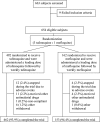Randomized, double-blind study of the safety, tolerability, and efficacy of tafenoquine versus mefloquine for malaria prophylaxis in nonimmune subjects
- PMID: 19995933
- PMCID: PMC2812156
- DOI: 10.1128/AAC.00354-09
Randomized, double-blind study of the safety, tolerability, and efficacy of tafenoquine versus mefloquine for malaria prophylaxis in nonimmune subjects
Abstract
This study represents the first phase III trial of the safety, tolerability, and effectiveness of tafenoquine for malaria prophylaxis. In a randomized (3:1), double-blinded study, Australian soldiers received weekly malaria prophylaxis with 200 mg tafenoquine (492 subjects) or 250 mg mefloquine (162 subjects) for 6 months on a peacekeeping deployment to East Timor. After returning to Australia, tafenoquine-receiving subjects received a placebo and mefloquine-receiving subjects received 30 mg primaquine daily for 14 days. There were no clinically significant differences between hematological and biochemical parameters of the treatment groups. Treatment-related adverse events for the two groups were similar (tafenoquine, 13.4%; mefloquine, 11.7%). Three subjects on tafenoquine (0.6%) and none on mefloquine discontinued prophylaxis because of possible drug-related adverse events. No diagnoses of malaria occurred for either group during deployment, but 4 cases (0.9%) and 1 case (0.7%) of Plasmodium vivax infection occurred among the tafenoquine and mefloquine groups, respectively, up to 20 weeks after discontinuation of medication. In a subset of subjects recruited for detailed safety assessments, treatment-related mild vortex keratopathy was detected in 93% (69 of 74) of tafenoquine subjects but none of the 21 mefloquine subjects. The vortex keratopathy was not associated with any effect on visual acuity and was fully resolved in all subjects by 1 year. Tafenoquine appears to be safe and well tolerated as malaria prophylaxis. Although the volunteers' precise exposure to malaria could not be proven in this study, tafenoquine appears to be a highly efficacious drug for malaria prophylaxis.
Figures
References
-
- Bernstein, H. N. 1983. Ophthalmologic considerations and testing in patients receiving long-term antimalarial therapy. Am. J. Med. 75(Suppl. 1A):25-34. - PubMed
-
- Boudreau, E., B. Schuster, J. Sanchez, et al. 1993. Tolerability of prophylactic Lariam regimens. Trop. Med. Parasitol. 44:257-265. - PubMed
-
- Bragonier, R., H. Reyburn, P. Nasveld, et al. 2002. Rainy-season prevalence of malaria in Bobonaro district, East Timor. Ann. Trop. Med. Parasitol. 96:739-743. - PubMed
-
- Centers for Disease Control and Prevention. 2003. Health information for international travel, 2003-2004. U.S. Department of Health and Human Services, Public Health Service, Atlanta, GA.
Publication types
MeSH terms
Substances
LinkOut - more resources
Full Text Sources
Other Literature Sources
Medical



